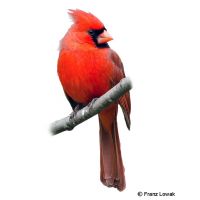Northern Cardinal (Cardinalis cardinalis)
| Northern Cardinal Cardinalis cardinalis | |
|---|---|
| Name | Northern Cardinal |
| Name Lat. | Cardinalis cardinalis |
| Family | Cardinals |
| Family lat. | Cardinalidae |
| Order | Perching Birds |
| Order lat. | Passeriformes |
| Origin | North America |
| Climate | Temperate - subtropical |
| Diet | Cardinal seed, sprouts, buds, fruits |
| Keeping | Pair, group |
| Care Level | Moderate |
| Reproduction | Cup nest |
| Life Span | 10-15 years |
| Protection | No |
| Metric Units | |
| Size | 21 cm |
| Temperature | Room temperature |
| Housing | 120 x 50 x 50 cm |
| US Units | |
| Size | 8.3" |
| Temperature | Room temperature |
| Housing | 45" x 20" x 20" |
Distribution and habitat
The wild form of the red-cardinal is distributed from southeastern Canada through the eastern United States to Mexico. There they live mainly in farmland, hedgerows, parks and forest edges. Today they are only available as a cultivated form.
Cage size
The minimum cage size is 120 x 50 x 50 cm (L x W x H) for a pair, whereby young birds are not considered until they become independent. The cage size may not be undercut even in the case of justified single keeping. For an additional 2 birds, species compatibility provided, the floor space must be increased by 25%. The cage must be placed in a bright, draft-free and quiet place at a height of at least 80 cm (except aviaries), have a rectangular base and be opaque on three sides, aviaries on one side.
Maintenance
The ground must be covered with sand, leaves, wood granulate, bark mulch or similar material and must be cleaned regularly. They need perching, hiding, roosting and nesting opportunities, as well as biotope-like furnishings with grasses, shrubbery and natural planting. At least 3 perches made of wood or branches of varying thickness and height must be installed in such a way that they can only be reached by flying and that the longest possible flight distance is created. Bathing facilities must be available at all times. The room temperature should not fall below 15 °C.
Diet
The species-specific food offer consists of mixed seeds available in specialized trade as "cardinal food mixture" in premium quality, in addition, foxtail millet, green millet, chickweed germinated seeds, fresh buds, fruit (apples, pears, etc.) as well as berries and especially for rearing young germ food, egg food, insects and insect larvae (mealybug larvae, ant pupae, pinkies, buffalos). As a digestive aid they need shell grit, cuttlefish and vitamin lime. Drinking water must always be available in birdbaths or in stable, open containers and, like food, must be offered fresh daily in clean containers.
A regular and varied diet promotes health and prevents deficiency symptoms.
Reproduction and breeding
The sexes are easily distinguished, females are predominantly grayish brown and faintly colored red on the hood, throat, and wings.
They like to breed in open larger cup-shaped nest bases made of netting or also freely in dense bushes. Suitable nesting material is sisal, coconut fiber, sharpie, moss. The clutch consists of 3-4 eggs, the incubation period is 12-14 days. The incubation period is, biologically speaking, from March to August when kept in open-air aviaries.
Important
The birds may only be kept in pairs or groups. During the breeding season, Red Cardinals may only be kept in pairs
They must not be kept in a round cage. An indoor aviary with a floor space of at least 0.6 m² and 1.5 m in height is recommended.
They may be kept in outdoor aviaries year-round, provided a dry, draft-free shelter or a covered, sheltered aviary section is available to them. The furnishings must be the same as those used for cages.
In rooms, including shelters, adequate daylight or flicker-free artificial light (stroboscopic effect), corresponding to the light spectrum of natural sunlight, must be provided. The lighting duration must be between 8 and 14 hours per day. The day-night rhythm must be observed. An adequate indoor climate must be provided. The health condition of the birds must be checked daily. If they are kept in cages, they should be allowed regular indoor free flight.
Further literature can be found in your pet store.
References
Text: Othmar Sieberer; Image: Franz Lowak
Source: BMELV (1995): Tierschutzgutachten - Mindestanforderungen an die Haltung von Kleinvögeln; ROBILLER (1986): Lexikon der Vogelhaltung, Edition Leipzig; GRUMMT & STREHLOW (2009): Zootierhaltung - Tiere in menschlicher Obhut: Vögel, Verlag Harri Deutsch
- Gemäß § 21 Abs. 5 Tierschutzgesetz idgF
